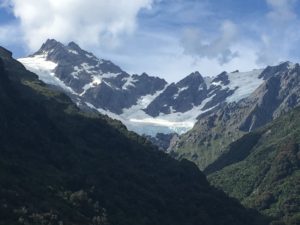South Island: A Glacial Warming Wonderland
After a month spent on the beaches of New Zealand’s North Island, I was ready for the glaciers, fiords, and jagged peaks of the South Island’s Southern Alps. To my surprise, my journey to ice and tundra, was met with heat waves and cyclones. Although I adjusted, I wasn’t quite prepared for a tour de climate change!
The South Island’s landscape is brilliantly diverse—giant mountain ranges, lush temperate rainforests, high desert tussock grasslands, even sparkling white beaches and emerald waters. It’s where you will find the most tourists seeking Lord of the Rings adrenaline adventures. It’s also where you will find more protected areas and dramatic scenery competing with New Zealand’s great expanse of dairy farms and Monterey pine forestry.
The Southern Alps capture continual precipitation from turbulent storms of the Southern Ocean and Tasman Sea. Over 240 in. (+6,000 mm) of annual rain falls on South Island’s west coast, bordering the Alps. Once I saw consecutive days of sun in the forecast, I decided to B-line to the clear skies above the great glaciers that flow to the west coast from Mt. Cook’s summit at 12,218 ft (3,724 m).
On the way, I made one, well-deserved pitstop to the Abel Tasman National Park coastal track—a blissful slice of paradise in the northwest corner of South Island. The heat was so intense, I resorted to hiking the track in my bikini. Any chance I could get to cool off, I jumped in the sea and swam across estuary mouths with stingrays and long-tailed eels.
Several days later, I was still hiking in my bikini, except I was much further south, heading up to the Franz Josef Glacier and Mt. Cook’s Copland Pass from sea level. Lugging my huge backpack up a mountain range in a sweltering heat wave was a bit brutal. I never imagined I’d be viewing glaciers and snow-capped peaks in Tahiti weather? Just didn’t feel right. But it certainly was rewarding once I found myself bathing in ice cold cascade springs above bushline with full views of Mount Cook at sunset. The experience overall was beyond remarkable. It’s not everyday I get to see rare whios (blue ducks) zip up and down the bright blue Karangarua River; soak in natural hot springs along the trail; and meditate to echoing calls of keas (alpine parrots) near blooming flame-red pohutukawa trees at bushline.
It’s also not everyday I get to see receding glaciers all around me and encounter endangered birds! Sadly, many of New Zealand’s glaciers are on track to disappear entirely in the coming years. This same fate is shared by New Zealand’s native birds. Even the iconic kiwi population is down 90% in the face of introduced pests (rats, stoats, cats, and opossums). I often found myself hiking long distances in hot weather on the trails debating which might disappear first in New Zealand—glaciers or endangered birds?
All along New Zealand’s vast trail network, trampers will find pest control in action. Department of Conservation (DOC) is ambitiously distributing traps and poison (such as 1080) to kill off anything with fur preying on feathered natives. Note: the only native mammals with fur in New Zealand, are three species of bats, which are also endangered. New Zealand, like Hawai’i, are Pacific islands dominated by birds with no predators. That is, until people arrived.
The jury is out if New Zealand’s government will succeed in eradicating rats, stoats and opossums. For the sake of native birds, I sure hope they do! There are several controversial ramifications involved in poisoning the entire country to eliminate bird killers. It strikes me as similar a pursuit in getting the United States and China to agree on becoming carbon neutral in a quickly warming planet.
Everyone knows, some apathetic, some don’t care to admit: we may lose the wide majority of our planet’s iconic glaciers in this lifetime as a result of human-induced greenhouse gases, increasing at astronomical rates. Taking humans out of the equation, earth scientists expect the planet’s climate to be stable for another ~10,000 years before Milankovitch cycles are due to trigger the next age of ice. Earth’s ice threshold is dominated by periodical orbit changes, on 10,000-, 30,000- and 100,000-year cycles. Geologically speaking, glacial ice stands no chance in a greenhouse planet. At the end of the day, I encourage everyone to add glacier viewing to their bucket list while they last!
Back on the Copland track, my heat wave quickly turned into Cyclone Feti. Rivers and waterfalls began raging, followed by flash floods and rock avalanches. I felt lucky to get out of the U-shaped glacial valley when I did. The rivers became impassable for my next planned trek in Mt. Aspiring National Park. Plus the sand flies literally were eating me alive on the west coast—to the point my ankles became too swollen to walk. So I decided to escape to the rainshadow (dry side) of the Southern Alps. When I woke up in Wanaka (Otago region) after the cyclone, the mountains were covered in summertime snow. It was quite a dramatic change in climate (!) and utterly beautiful.
Now Cyclone Gita, a few weeks later, is approaching New Zealand. I must once again cancel my plans and seek solid shelter to ride out the next tropical storm. On the micro-level, is tour de intensifying cyclones. On a macro-level, is tour de force of enormous importance for our planetary future! I have long debated if we earthlings are prepared for the latter tour coming our way? This is the golden question of modern time…


Franz Josef Glacier and Sierra Range glaciers near Mt. Cook


Abel Tasman National Park


Karangarua River and rare blue ducks (photo: NZ Bird Directory)


Cascade bathing above bushline in Copland Valley (Mt. Cook to the left)


Blooming pohutukawa trees in the Sierra Range


Copland hot springs and kea (alpine parrot, Photo: Dept. of Conservation)